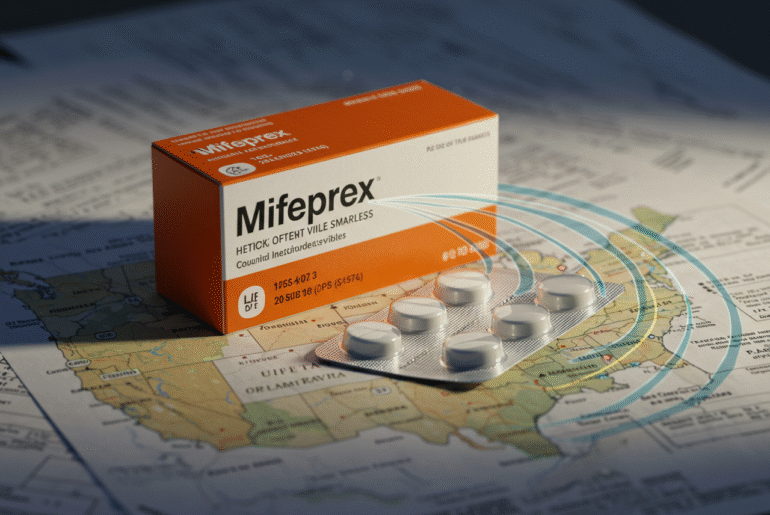This article may contain references to products or services from one or more of our advertisers or partners. We may receive compensation when you click on links to those products or services. Nonetheless, our opinions are our own.
The information presented in this article is accurate to the best of our knowledge at the time of publication. However, information is subject to change, and no guarantees are made about the continued accuracy or completeness of this content after its publication date.
- Mifepristone Access and the Fight for Abortion Rights
- Legal Reasons Behind the Push for Change
- What Could Change Mean for Individuals?
- State Policy Differences and Local Access
- Financial Burden of Limited Reproductive Services
- Telehealth’s Growing Role in Abortion Access
- FDA Approval Challenges and Ongoing Legal Disputes
- How Government Rules Affect Abortion Pills
- Doctors Want FDA to Remove Mifepristone Barriers After 25 Years of Safety
- How Mifepristone Works and Why It Matters
- Prevalence of Mifepristone Use in the U.S.
- Clearing Up Myths About Mifepristone
- Why Access to Mifepristone Matters for Reproductive Care
- Highlights
- Frequently Asked Questions
- What special rules are there right now for the abortion pill?
- Which states want to lift these restrictions?
- Why do they want the rules removed?
- What could happen if these restrictions are lifted?
- How has the FDA responded?
- Are there legal fights about this now?
- Why is it important to distinguish mifepristone from the morning-after pill?
- Recommended Reads
Mifepristone Access and the Fight for Abortion Rights
In the last few months, the talk in the United States about reproductive health and getting abortion services has changed in some big ways. Four states are now asking the Food and Drug Administration (FDA) to get rid of certain rules on the abortion pill called mifepristone. A lot of people are talking about what this could mean, both for this medicine and for the bigger issue of what care people can get.

As you read more about this, you will see the reasons these states want the rules changed, learn about the current laws, and find out how the federal rules shape what people can do when they want to make choices about their bodies. This talk about mifepristone is about more than just one pill. It deals with questions about who can get care, fairness under the law, and what is happening in our country right now with these problems.
Legal Reasons Behind the Push for Change
When we look at the legal fight about abortion pill rules, we need to know why four states have come together for this cause. They say that today’s rules limit people’s ability to get safe and good care, which a lot of people depend on. Supporters say that if these rules go away, many more people will have the chance to make their own choices about their bodies in a way that also follows current medical practice.
What Could Change Mean for Individuals?
Easing rules can have a big impact. Think about how this change might touch your life or the lives of people you know:
- Increased Access: When the abortion pill is easier to get, more people will have the chance to find safe care at the right time.
- More Choice: Being able to choose gives people new power. It helps them put their needs and what is going on in their lives first, without a lot of extra rules in the way.
- Health Provider Support: Doctors and nurses get better rules to follow. This builds trust and gives support to the people who come to them for help.
State Policy Differences and Local Access
State governments are playing a bigger role, along with the FDA, when it comes to reproductive healthcare in the US. In the past few years, several states have chosen very different paths. Some states are working to increase abortion rights, while others have made strict rules against it. Because of this big split, your access to care depends on where you live.
Places like California and New York keep finding new ways to allow more people to get help and be protected by law. Other states are adding new limits that make it harder to get services. These big changes show why rules on the federal level, like the FDA’s limits on mifepristone, matter. Sometimes these rules help give people more options, and sometimes they make it harder to get care. This all depends on how strict the mood and laws are in each state.
Financial Burden of Limited Reproductive Services
When it is hard to get the care you need for having kids or not having kids, the cost for each person goes up a lot. People who need to go to another state for this care have to pay for things like travel, a place to stay, and missing work. This is hard, especially for people who do not have much money. Also, if you have to wait to get care, the problem can get worse, and then the care you need can be harder to get. This makes the cost go up even more. If rules on mifepristone are lifted and you can get it nearby, some money worries can get better. For many people, being able to decide about having kids is not just about what they want. It is about having enough money and being able to plan for what will happen later.
Telehealth’s Growing Role in Abortion Access
Telemedicine is now a strong way to help more people get safe and fast healthcare. This helps people in rural places and other areas that do not have enough doctors. When mifepristone is prescribed by trusted telehealth providers, more people who would have big problems getting care in person can get it. This is true whether the problems are about travel, time, or wanting privacy. But REMS rules right now limit how much telehealth providers can do this. If the FDA changes its rules to let telehealth providers send this medicine in more ways, then more people could get private and fast care. They would not have to deal with in-person office rules that are hard or take a lot of time. Telehealth also helps the whole health system by letting care happen in more than one place and letting doctors and workers do things in a way that works for them.
Voted "Best Overall Budgeting App" by Forbes and WSJ
Monarch Money helps you budget, track spending, set goals, and plan your financial future—all in one app.
Get 50% OFF your first year with code MONARCHVIP
FDA Approval Challenges and Ongoing Legal Disputes
The ongoing legal issues with mifepristone have made things feel stressful in the area of reproductive healthcare. People are now worried about if FDA approvals will stay strong and what these court cases could mean for patients trying to get this medicine. Some states have made laws to block or stop the use of this medicine. They say it is about “protecting life,” but at the same time, they do not listen to doctors, even though many doctors agree this drug is safe and works well. These court cases do not just make things unclear for doctors and other care workers, but they also make patients feel scared about using this medicine as part of their care. The FDA has an important job now as it deals with all these big changes and problems.
How Government Rules Affect Abortion Pills
Government rules and restrictions keep making it hard to get medication abortion, especially when it comes to mifepristone. Different states pass laws that try to put tight rules on who can get this important medicine. This means people where the rules are stricter have a harder time getting care, while others might find it easier in their area. The rules can include things like having to wait a certain number of days, going to special counseling, or setting limits on where and how mifepristone is given.
These rules make it much harder for people in already struggling groups to get care. Their options get smaller. Many have to travel far from their homes or try ways that are not as safe to get the help they need. This shows that, in the US, your access to important care can depend on where you live and who you are.
Doctors Want FDA to Remove Mifepristone Barriers After 25 Years of Safety
In a joint petition, the Society for Maternal-Fetal Medicine and the American College of Obstetricians and Gynecologists (2025) called on the FDA to eliminate the remaining REMS requirements for mifepristone. The petition noted that the medication has “an extensive safety and efficacy record” and that the current restrictions are not medically justified. These professional medical organizations emphasized that the REMS program creates unnecessary barriers to care and delays treatment, especially for individuals in areas with limited access to reproductive health services. They argued that lifting these limitations would allow clinicians to provide care in alignment with best medical practices and reduce the financial and logistical burdens on patients.
How Mifepristone Works and Why It Matters
Mifepristone is now seen as an important pill in medication abortion. It gives a safe and good way for people who want to stop a pregnancy in the early stages. The pill works by blocking a hormone called progesterone. This helps the embryo come off the uterine wall. After that, another pill, misoprostol, is taken. This pill makes the womb cramp and pushes the pregnancy out. This mix of two pills is used by many doctors and people because it works well, and there are not many problems with it.
Prevalence of Mifepristone Use in the U.S.
Mifepristone is now used more in the United States. Studies show that it makes up a large part of medication abortions. Recent numbers say that more than half of all abortions in the U.S. use this two-drug plan. This shows how important mifepristone is in healthcare for people who need help with pregnancy. It is easier to get, and more people are open to it now. Because of this, doctors can use it in their work. They can now give people an option that does not need surgery.
Clearing Up Myths About Mifepristone
Many people still have some wrong ideas about mifepristone, even though more doctors and others accept it now. One common idea is that it is very risky for your health. But a lot of research shows that if you use it the right way, it has a low risk of problems. Another belief is that mifepristone will cause long-term pain, both in your body and in your feelings. But most people feel okay with their choice and only have mild side effects. Some also mix up mifepristone with emergency birth control because they think the two do the same thing, but they do not.
Why Access to Mifepristone Matters for Reproductive Care
Access to mifepristone is very important for the health of women, as it helps people have more say over their bodies and leads to better health for them. This pill lets patients make informed choices in private and gives them help and support. It helps to lower the shame often felt around abortion. Also, mifepristone helps open up more ways for people to handle their reproductive needs. It gives a safe choice that is not surgery, which is helpful for those who cannot get to clinics easily or do not have enough money to get other care.
Highlights
- Mifepristone is central to early-stage, non-surgical abortion care in the U.S.
- Four states are urging the FDA to remove restrictions that limit access.
- Legal and policy battles continue to shape who can access this medication.
- Telehealth and expanded access can reduce travel and financial burdens.
- Clear knowledge and public education are needed to overcome myths and stigma.
Frequently Asked Questions
What special rules are there right now for the abortion pill?
Mifepristone currently falls under the FDA’s REMS program, meaning it can only be dispensed by certified providers in specific settings. This limits access for many people.
Which states want to lift these restrictions?
California, New Mexico, New York, and Washington are leading the request to remove FDA-imposed limitations on mifepristone access.
Why do they want the rules removed?
They argue the rules restrict safe healthcare access and that lifting them would help more people make personal health decisions in line with medical standards.
What could happen if these restrictions are lifted?
Access would improve, more providers could offer mifepristone, and people might not need to travel or wait as long for care.
How has the FDA responded?
The FDA has not yet officially changed its rules but may revisit the restrictions based on legal and policy challenges.
Are there legal fights about this now?
Yes, ongoing lawsuits at both the state and federal levels are challenging how mifepristone can be used and prescribed.
Why is it important to distinguish mifepristone from the morning-after pill?
The morning-after pill prevents pregnancy before it starts, while mifepristone ends an early pregnancy. Confusing the two leads to misinformation about their purpose and timing.

Reviewed and edited by Albert Fang.
See a typo or want to suggest an edit/revision to the content? Use the contact us form to provide feedback.
At FangWallet, we value editorial integrity and open collaboration in curating quality content for readers to enjoy. Much appreciated for the assist.
Did you like our article and find it insightful? We encourage sharing the article link with family and friends to benefit as well - better yet, sharing on social media. Thank you for the support! 🍉
Article Title: States Challenge FDA Restrictions on Abortion Pill
https://fangwallet.com/2025/06/28/states-challenge-fda-restrictions-on-abortion-pill/The FangWallet Promise
FangWallet is an editorially independent resource - founded on breaking down challenging financial concepts for anyone to understand since 2014. While we adhere to editorial integrity, note that this post may contain references to products from our partners.
The FangWallet promise is always to have your best interest in mind and be transparent and honest about the financial picture.
Become an Insider

Subscribe to get a free daily budget planner printable to help get your money on track!
Make passive money the right way. No spam.
Editorial Disclaimer: The editorial content on this page is not provided by any of the companies mentioned. The opinions expressed here are the author's alone.
The content of this website is for informational purposes only and does not represent investment advice, or an offer or solicitation to buy or sell any security, investment, or product. Investors are encouraged to do their own due diligence, and, if necessary, consult professional advising before making any investment decisions. Investing involves a high degree of risk, and financial losses may occur including the potential loss of principal.
Source Citation References:
+ Inspo
Society for Maternal-Fetal Medicine & American College of Obstetricians and Gynecologists. (2025, January 31). Citizen petition to eliminate REMS restrictions on mifepristone.












































